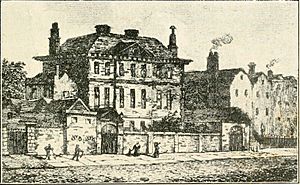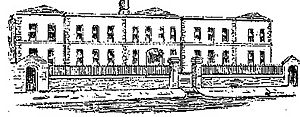Mendicity Institution facts for kids
The Mendicity Institution is one of the oldest charities in Dublin, Ireland. It helps people in need by providing meals and other support. The charity still works from its building, Moira House, on Island Street. This is close to Usher's Island, where it used to be located.
Contents
History of Helping Others
How it Started
In 1817, some business people met and decided to start a new charity. They were inspired by similar groups in other European cities. So, in 1818, the Mendicity Association began.
Its main goal was to give food, clothes, education, and a place to stay for poor people in Dublin. At that time, there was no big government system to help people who were struggling. Many charities like this one were set up to help with the widespread poverty in the city.
Before the Institution moved in, Moira House was the home of the Earl of Moira. It was built for him in 1752.
The early Mendicity Association had a large committee of 60 people. They hired staff to manage the charity, teach, and help with medical needs. They also had people who checked on the streets to find those who needed help.
The charity focused on helping people who lived in the main part of Dublin. They wanted to keep families together. They also ran schools for boys and girls. By the end of its first year, the charity was helping almost 3,000 people. This included over 680 children, with 280 of them going to school. They also helped about 320 elderly and disabled people.
A key part of the charity's work was asking adults who could work to do tasks. These tasks included making lace or preparing materials for building. People earned a small amount of money for their work, but some of it went towards paying for their food.
The charity also helped people move to new places if they had a job offer. If someone was from another country, the charity could help them go back home. People had to work at the Institution for four weeks while their situation was checked. If approved, the charity would pay for their travel. They even got discounts from train and ferry companies.
After the Poor Laws
Later, new laws called the Irish Poor Laws were introduced in Ireland. These laws led to the opening of "workhouses" in Dublin. These were places where poor people could live and work. Because of these new systems, fewer people needed help from the Mendicity Institution. The number of people they helped each day dropped to about 400.
However, during the Great Famine, the demand for help rose again. Over 2,500 people needed assistance. In 1852, the Institution stopped running its own school and pharmacy. Instead, it helped people pay for these services from other places.
In the same year, the charity opened public baths. This was done to help people in the city stay clean and healthy. These were the first public bathing places in Dublin. Queen Victoria even donated money to help fund them. The baths had 33 regular bathtubs and one for Jewish religious bathing. They stayed open until 1909.
The 20th Century and Beyond
By the 1900s, the charity's main work was providing meals for people in need. The number of meals served each day sometimes dropped very low, to about 30. But in the 2010s, the demand for meals started to rise again.
Where the Charity Has Been Located
The charity first started its work on Hawkins Street, renting a building there. Then, it moved to Copper Alley.
In 1826, the Institution moved to Usher's Island, close to the River Liffey. This was after Edward Parke had changed the old Moira House building for the charity. Moira House used to be the family home of Lord Moira.
The building has an interesting history. On May 18, 1798, Pamela, the wife of a rebel leader named Lord Edward FitzGerald, was at the house. Her husband was captured nearby that evening.
During the 1916 Rising, a leader named Seán Heuston was told to take over the Mendicity Institution. He was supposed to hold it for a few hours to slow down British troops. But he and 26 other volunteers held the building for more than two days! Eventually, they had to give up because there were too many British soldiers. Seán Heuston was later executed. The building was damaged during the fighting. The government paid some money for repairs, but it only covered about two-thirds of the cost.
The Institution stayed at Usher's Island until 1954. The old building was taken down in 1960. However, the front gate and railing are still there today.
What the Charity Does Now
The charity has a few staff members and many volunteers. From 2018 to 2020, its services included:
- A meal service for people who are homeless or struggling. They offer breakfast, lunch, and a light afternoon meal five days a week.
- A phone service to help homeless people who have moved from other countries. They offer support in English, Russian, Romanian, and Polish.
- Classes to help people learn to read and write. This includes teaching English to people who speak other languages. They also teach computer skills.
- Help with finding jobs and settling into life in Ireland.
- A workshop where people make things from wood and metal. These items are sold at markets and online.
Most of the people the charity helps do not speak English as their first language. So, there are staff members who can speak Polish, Romanian, and Russian to help them.
In 2015, the charity also offered a homework club with food for local children.
How it is Run and Funded
Some of the charity's projects get money from the government. For example, the work to help people find jobs gets support from the Department of Justice. But the meal service is paid for entirely by donations and the charity's own money.
The charity has four important supporters: the Roman Catholic and Church of Ireland Archbishops of Dublin, and the Deans of St. Patrick's and Christ Church Cathedrals. A Managing Committee oversees the charity. Its money and buildings are looked after by a small group of trustees. In 2018, the charity had almost 3 million euro saved for its work. The Mendicity Institution is officially registered as a charity.
See also




